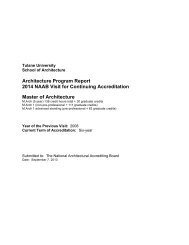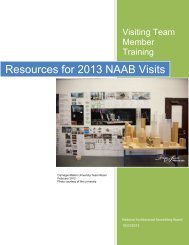Architecture Program Report Tulane University New Orleans ...
Architecture Program Report Tulane University New Orleans ...
Architecture Program Report Tulane University New Orleans ...
You also want an ePaper? Increase the reach of your titles
YUMPU automatically turns print PDFs into web optimized ePapers that Google loves.
design studio is the “site” of that union.<br />
The first three years in the current studio sequence (in the M.Arch I postbaccalaureate<br />
program, the 2.5 years) represent the student’s “core” education in<br />
design. These studios are taught by several faculty; the material for the studio is<br />
developed collectively under the oversight of the Year Coordinators. Hence,<br />
students, while having access to a wide variety of points of view, nonetheless<br />
have the identity of a smaller section (12-13 students per instructor) along with a<br />
more personal relationship to their particular studio section leader.<br />
The First-year “experience” occurs in the first two semesters, for the<br />
undergraduate student, and the condensed summer studios for the graduate<br />
student. The First-year curriculum introduces students to a broad understanding<br />
of the culture of architecture, as well as the multiple landscapes in which the<br />
discipline and practice of architecture operate. Hence, students are given studio<br />
programs and skills courses (the representation courses) that are conditioned by<br />
multiple scales, uses, human factors, and material, constructional, and<br />
environmental parameters. Students are also introduced to architecture as a form<br />
of research as well as the kinds of research that inform the development of an<br />
architectural idea. The idea of architecture as a form of research includes not<br />
only the notion of architecture as a critical mode of inquiry, but empirical<br />
research―the considerations surrounding “learning to see” as well. In addition,<br />
the nature of criticism, the language associated with architectural ideas, and the<br />
ethics of practice are discussed.<br />
First-year studio is aided and abetted by two key courses during the spring<br />
semester, History of <strong>Architecture</strong> I and Technological Systems. In these courses,<br />
students are introduced to the myriad environments that inform the culture of<br />
architecture and content that informs their studio production from both a historical<br />
and technological point of view. These environments include the history and<br />
theories associated with architectural production, technology and structures, and<br />
“paradigmatic” ways of thinking about the discipline and practices of architecture.<br />
Hence, students are granted an awareness of the broader circumstances that<br />
condition architectural research both as a knowledge-based inquiry and as a<br />
practical pursuit.<br />
As students begin their technology sequence, they engage the theoretical and<br />
practice issues of statics, construction materials and assemblies and technical<br />
documentation. This approach allows students to begin to understand the<br />
underlying principles associated with architectural construction so that they may<br />
be able to not only understand the substantial and practical knowledge<br />
associated with technology, but are able to intuitively comprehend the role and<br />
measure of technology in architecture. This is also the case with history: students<br />
are introduced to the fact that architecture is historically and culturally bound and<br />
cultural thinking is an endemic requirement in architectural design. This material<br />
is affirmed by the design studio practices in two ways: through programs that pay<br />
particular heed to the material being presented in the parallel coursework. In<br />
this way, technologies (which includes structures) are not something to be<br />
applied after the fact of design, but becomes an integral component of the design<br />
process itself – in the same manner that formal criteria may be used to critically<br />
evaluate a given project, structures and technology can also be used as critical<br />
tools. The accelerated complexity and depth of the technology/structures<br />
sequence, built on a strong conceptual foundation, conditions the design studio<br />
sequence, thus preparing the student to consider architecture as an integrative














